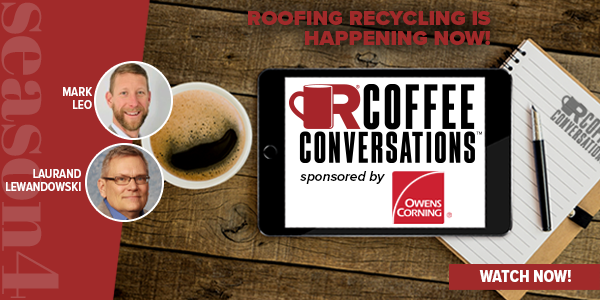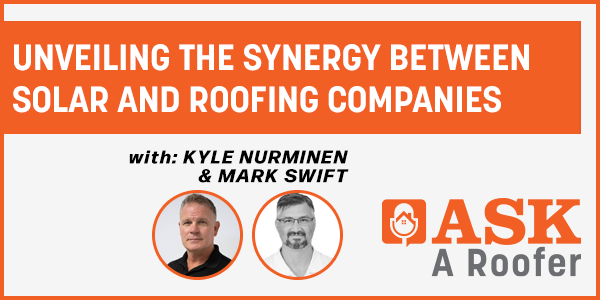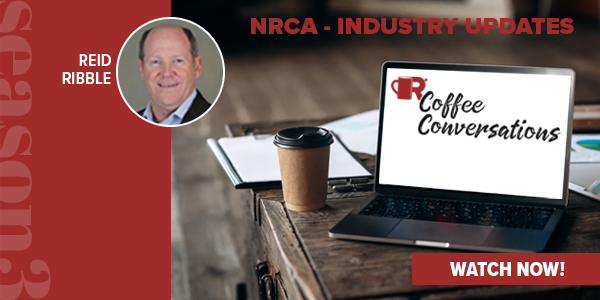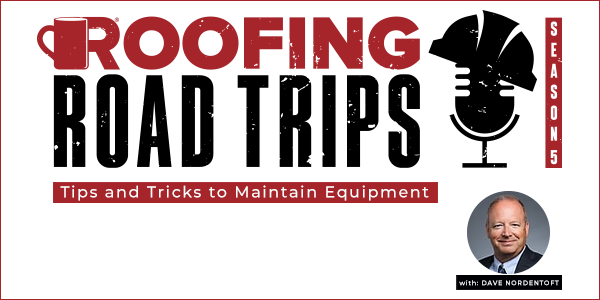Dave Nordentoft - Tips and Tricks to Maintain Equipment - PODCAST TRANSCRIPTION
August 15, 2023 at 2:00 p.m.Editor's note: The following is the transcript of a live interview with Dave Nordentoft from Leister. You can read the interview below or listen to the podcast.
Intro/Outro: Welcome to Roofing Road Trips with Heidi. Explore the roofing industry through the eyes of a long-term professional within the trade. Listen for insights, interviews, and exciting news in the roofing industry today.
Heidi J. Ellsworth: Hello and welcome to another Roofing Road Trips from Roofers Coffee Shop. This is Heidi Ellsworth, and we are here today to talk a about fun step and that is tools, tips, and tricks for maintaining your tools. So of course we had to bring in the expert from Leister, Dave Nordentoft. Dave, welcome back to the show.
Dave Nordentoft: Good morning, Heidi. Thank you. It's pleasure to be back.
Heidi J. Ellsworth: Oh, I love it. This is one of my favorite topics. I guess we are a little bit of roofing nerds, but it's kind of fun to talk about all the tools and what really makes things happen on the roof. We have to admit that. So before we dive in, can you introduce yourself and tell us just a little bit about Leister?
Dave Nordentoft: Absolutely. Sure. I'm the product manager for the roofing category Leister. I've been with the company now for just over nine years, but again, I'm a roofing career guy. So I've been in the industry for close to 36 years in different roles. I've been in the material distribution side of the business, manufacturing side, sales, marketing, that type of thing, but like you said, once it gets in your blood, it gets in your blood, but I love what I do and I love working with roofing contractors and I love the industry.
But yeah, Leister has been around since 1949. The company was founded by Karl Leister since 1949. Actually, a little tidbit here, little known fact. The first tool or machine that Karl Leister produced was actually a handheld vacuum, believe it or not. It was called the [inaudible] 3,200 manufacturing facilities in his parents' basement in Germany.
So it started out modest and small and things just took off from there. So yeah, it was in the early 1950s when he actually developed his first hot air hand tool called the Combi, which we have a different version of that still today. It's called the TRIAC, which is the tried and true hand welder for welding thermal plastics, including in the roofing industry and everything sort of is based on the foundation of that original hot air hand tool. So we get ourselves involved in a lot of different industries and a lot of different technologies and industry sectors, but of course a lot of people know us for what we do in the roofing industry.
So again, we're going to be celebrating our 74th anniversary in business this year and still going strong and still trying to be innovators and bringing new products out to the market and that type of thing. So things are going well.
Heidi J. Ellsworth: Well you know, everyone knows Leister. I mean Leister is just the leading heat welding, but I mean so many others. You have so many other pieces of equipment also, but I really wanted today to talk about, I mean, you are the expert, Dave, so there's just so much that goes into maintaining your heat welding equipment and keeping it so that you have production, safety, ease of use, all those different things. Talk to us a little bit about what you're seeing out there on the rooftop right now and some of the tips and tricks of maintaining that heat welding equipment.
Dave Nordentoft: Sure, exactly and Heidi, you're absolutely right. I mean, the old saying is you take care of your tools and your equipment and the equipment will take care of you. So I think a lot of people get in the routine of their daily grind. They're doing everything working hard, and sometimes it's hard to sometimes take the time to step back away and say, "What should I be doing to take care of?" And it's not just life Leister heat welding equipment. It's really any tools and equipment that help you be productive and help your company make money.
And so some folks tend to take time when things slow down, if there is a slow down, if there is an off season in the roofing industry, they'll sometimes use those opportunities to step back and say, "Okay, well maybe I should take a look at my equipment and do some regular maintenance or maybe even some preventative maintenance," but really for these tools to operate optimally, there should be some care and some time taken to take a look and again, it's not anything that requires a tremendous amount of time and attention. I think roofing contracting company owners and superintendents should be encouraging their employees that are working with the tools on a regular basis to be paying attention to the tools and look at these things on a daily or weekly basis and saying, Hey, again, they all saying see something, say something, right? So if you see something has happened with a piece of equipment, just don't overlook it.
Maybe there's something that should be done from a maintenance standpoint to make it so it doesn't become a bigger problem because again, at the end of the day, these contractors, they need this equipment to be operating and operating properly so that the jobs are done properly and the welds are done properly, but they're also part of the overall productivity. So if a piece of equipment breaks and is not in service, guess what? We're not productive anymore unless you happen to have a backup in your back pocket, so to speak. That also can really affect the ability to be productive in this day and age.
We're pushed up against tight labor and all these types of things and so being productive is really important these days. So anyway, so some of the things we talk about with contractors, I mean, let's start with just the hand tool. Again, that's like the bread and butter on every job site are these hand tools and really one of the most important things is the airflow. So at the one end of the hot air hand tool is the air intake and so there's a location where the air is drawn in, it's brought in through a turbine and impellers and brought in and pushed through the tool through a heating element that heats the hot air and then brings it out the other end of the nozzle.
So how that air flows through there dictates to a certain degree how that tool is going to perform and things happen on job sites. Job sites are dirty, so there's different things like dust and dirt, particulate matter that'll get drawn into these tools. So it's not a bad idea to stop and take a break and check the filters, the intake filters, and make sure that those are clean. You can take the gun, open it up and use a little bit of compressed air to sort of clean that out. You can blow the element out-
Heidi J. Ellsworth: Right. That makes sense, yeah.
Dave Nordentoft: Yeah, so that you keep that airflow moving through there and at the same time, you can inspect an element for a crack or a char or something like that, but that's really one of the key maintenance factors for one of the hand tools. The other thing to check is the power cords and again, they end up, you overlook, think about, well, no big deal, but it's a huge deal and again, different folks take different degrees of care with their tools and equipment. Some things take a lot of abuse, and we build our tools to try to handle the rigors of job site use. They're built and designed to be able to handle that, but hey, things happen. So things get dropped. They get kicked around, they end up in the back of a truck or whatever and so things will get dent, dented the nozzles of the heater tubes, power cords will get pulled on like a leash and things fray, they get cut.
So these are all things that not only will affect whether the tool runs or not, but they can also end up being safety issues too. So again, I think these are all things that should be looked at and again, they're not huge time consuming things to do to fix and maintain. When you carry that over and you go into the automatic walk behind welders, there's a slightly different kind of hot air blower, but it's the same principle again. So if you have a hot air hand tool or you have an automatic walk behind welder, that same principle on how that air travels through that blower to deliver that air and that heat into that seam all is the same way.
So again, keep that air flow clean and then when you have the walk behind welders, there's sort of a walk around. We talked to contractors about that, and you think about it, there's consumables, there's things that wear out over time. Again, just like if you had a vehicle, things like tires, belts or hoses or whatever, there are things that wear out over time just from age or from use. So even in an automatic welder, those types of things can happen as well and again, those machines are subject to the same rigors often that the hand tools are. So you can have nozzles get dented.
We engineer the nozzles to very carefully deliver heat and airflow into the seam, and they're designed a certain way to do that, but if they get dented, if they get pinched, that's going to affect that airflow in the way that that heat is delivered within that and it can ultimately affect the weld quality if it's not looked after. We've seen all sorts of creative things happen.
Some folks will say, "I think I can improve the airflow or whatever," and so they'll do some creative things to nozzles to modify them or-
Heidi J. Ellsworth: Not a good idea.
Dave Nordentoft: Well, we don't recommend it, but hey, people are creative and I think I can improve this but anyway, we think that the way that we design the nozzles are optimal but again, things happen. Things wear out and so we tell folks that they should keep them clean, they should use a wire brush to try to remove any of the carbon matter or built up plastic residues or whatnot that'll build up on that just to try to keep it so that moves through that seam nice and smoothly, and to keep those holes open so that air and that heat is dissipated and dispersed properly during the welding process and again, we encourage people to look at these things very carefully.
Again, you look at things like the silicon rollers, the pressure wheel, again, that's where the rubber meets the road, so to speak. So that's where the real deal happens, but again, sometimes they crack or something will cut them or there'll be a fissure in them. So if you think about every time that wheel spins and if you're getting a point where there's a crack in that, it'll change the welding pressure at that moment in time every time that wheel rotates and those are just opportunities for an incomplete weld or a void to happen. So again, it's a relatively easy fix. It's a relatively inexpensive fix, but check your tires and then speaking of tires, there's also transport wheels as part of these welders.
Again, you should check those to make sure that those wheels are freely spinning and not bound up. Sometimes you can get a scrim caught in them or something and they don't spin freely that can pull on the machine. That could affect the way the machine tracks when it's on the roof and again, these are all just little things that all add up and sometimes can make a difference. And again, I can't stress enough the importance of checking the power cables, making sure they're secure, and the plug on the other end, make sure that that's the proper plug and that that's installed properly so you don't have any issues on the power supply side of it. So anyway, these are some of the things we tell people to take a look at right from the beginning when they can do a walk around or take the machine and turn on its side. Another thing, check the separation belt. We call it the green belt.
So it's just another thing that over time can stretch, the wheels that hold them down, can get bound up or can bend if something happens on a job site. And again, all these things can ultimately affect just how that machine performs or how it tracks on the roof. So it seems like a laundry list. I'm going on and on and on but again, these are all really simple things that are all external. I've never suggested that it's like, oh no, you need to lift up the hood and see what's going on underneath. These are all things that are right at your fingertips right in front of you, if you just take a couple minutes to do a walk around.
Heidi J. Ellsworth: And from a safety standpoint, and I know contractors do this, so I know all the good contractors are already doing this, but from a safety standpoint to really do that every morning, or I say before you start any job to just take the time to make sure the air flows going, that the power cords aren't frayed to really check out your walk behind, the rollers and the tires and stuff. That's just to me that is safety because you don't know what the person has done ahead of you and you want to make sure that what you are getting into is not going to backfire or cause any problems.
Dave Nordentoft: Yeah, absolutely. I just think it's a really call it a list of best practices, I think they should make it a habit just like you check your ladders or you check your perimeter and check for fall hazards or anything else that I think it's just good practice to make sure that the equipment's operating safely. You want to keep your workers safe and again, at the end, if you do that, you take care of your workers and you take care of the equipment and then everything's going to add up to a better quality job, a better run job site.
Heidi J. Ellsworth: Happier people, happier customers-
Dave Nordentoft: Happier people, safer people, better project when it's all done when you're walking on the roof.
Heidi J. Ellsworth: So one of the things you said earlier too, I think is just really important is that if they see something, if you're inspecting your tools and you see something, don't wait and you know what, Dave, I can kind of get that. It's like, I just want to get to the job, it's okay, I'll just use it today and we'll get it tomorrow, but that kind of tends to go on because the sooner you catch it, the earlier you catch problems and get it fixed with service departments, the better. I mean, the longer the tool's going to last and the higher the productivity, right?
Dave Nordentoft: Yeah, I think you nailed that one. I mean, absolutely and again, some of these things are very, very simple fixes, relatively inexpensive fixes and again, I think if you stay ahead of this, I think about especially things like power cables and this type of thing, because some of the issues that get into machine operations and machine errors and internal problems with circuit boards and things like that with power supply issues and that sort of thing, some of it really can get tied into just how the cables are maintained and how the power supply is managed.
Some of those things can ultimately end up damaging the equipment internally, then now you've got a machine that's down and now you've got some maintenance that could be a little bit more expensive, but sometimes this is avoidable just watching for some of these things
Heidi J. Ellsworth: To put it together. One of your best friends out there when it comes to your tools is your service department and you have service departments all over the country where people can get their machine or the tools serviced, tell us a little bit about that?
Dave Nordentoft: Yeah, we have a network of authorized sales and service centers all through the country. Independent companies that are, most of them are all specialty distribution companies for equipment, that type of thing. We have some that are also in a material supply side of the business, but basically they've all been trained. They all stock Leister product. They all have at least one service center within their companies to service Leister customers and we want to feel like roofing contractors have a local partner, someone within their local market that can respond to their needs on a timely basis and not have to send a tool all the way across the country or feel as if they're dealing with a company that it's like, I've got to send it to Switzerland or something. It's like, no, no, no, no. We want to have people in all the major markets well positioned to be able to service service our customers.
And so yeah, we have in excess of probably 40 physical locations total that are across the country, coast to coast to be able to help and service and keep these machines running and turn them around as quickly as possible, diagnose them as quickly as possible and get them back in the hands of folks that need to have them. So yeah, we lean on our distribution partners a lot, but they do a great job for us representing us in our local markets. They know the customers the best. They work with these folks sometimes over the generations. So we respect those relationships and our distribution partners do a great job of serving our local customers.
Heidi J. Ellsworth: Well and I mean, that's the thing is yes, you want to be checking it every time, every day you're on the job, but sometimes you just need to take your tools in to get service, like you said, during the winter months when things are a little bit slower just to make sure everything's running at its optimal performance level because that really does make a difference to the performance on the roof and maybe just touch on that just a little bit of when equipment is not running or tools are not running at their peak performance ability, it also then creates really profitability issues on the roof.
Dave Nordentoft: Well, yeah, there's productivity issues, but really first and foremost, I think there's quality management or quality control issues that could come up if the tools are not operating properly. If you think about the importance of the integrity of the welds on a thermoplastic roof system, this is something that to me would keep me up at night if I was worried about whether the welds were good and so there's the workmanship part of it, obviously, but there's also is the equipment operating and did it do its job today?
And so that maintenance and that care that's part of it just plays in and sometimes you just don't know. Sometimes a machine won't tell you that things aren't operating right or anything like that. So I think you just have to have well-trained people that know what they're looking for and know what to recognize if there's anything that looks like it's out of alignment or not calibrated properly or that type of thing, because again, those welds are critical to that roof's performance. And so I think more so again, safety, that's important too, but certainly if that machine's not operating properly and you're going to get called back or it's going to slow your productivity down, I mean, that's just money, that's just costing you money.
Heidi J. Ellsworth: Yeah, that's so true. Okay. I know we've been talking about the heat welding machines, equipment, tools, all of that, but I want to talk just for one second about, and you kind of touched on it earlier, power usage and generators on the roof, because that also can cause quite a bit of problems if it's not handled correctly. So can you talk about that, because we know you have to have it?
Dave Nordentoft: Yeah, absolutely and we don't manufacture portable power and we don't necessarily endorse any one particular manufacturer's product, but there are certain things that we typically will recommend. So we get asked very regularly, well, how big of a generator should I have, what kind of capacity should I have and that type of thing and so as a general rule, I'll paint with a big brush on this, but as a general rule, what we tell folks, first and foremost, they should have a dedicated generator to run their hot air welding equipment. They shouldn't be sharing a generator with any other rooftop equipment like drills or saws or anything like that.
So number one, you should have a generator to just operate the welding equipment. Number two, what they really should take a look at is the overall peak demand of the tool that they're going to run. So if it's, let's say a VARIMAT V2 welder, 4,600 watts, we say double what the needs are of that tools, and then that should be the baseline where you start in terms of capacity.
So we just want to make sure that people have plenty of power to be able to power that machine and maybe an extra hand welder or two on top of that. One of the other things to consider is also a little known thing, it's called THD or total harmonic distortion, but basically what it means is the machine's ability to produce what's known as clean power. Okay. It's a nice clean sine wave without getting too deep in this, but basically a dirty power or an inefficiently running generator generates a lot of extra current that ultimately creates the heat, which damages a lot of the sensitive electronic equipment because there are circuit boards in these machines, just like there is in computers and that type of thing.
So we tell when you're looking for specifications, look for a generator that produces no more than five or 6% total harmonic distortion or what would produce clean power, and that just helps run this equipment properly. So this is not an area where we suggest people cut a corner, so to speak. I mean, they've invested a lot of money in this equipment, and the investment really needs to be looked at and viewed from end to end, from the power source all the way through to the equipment and everything in between, including the proper cable, the proper plugs, the way the plugs are installed, and the generators need to be maintained as well.
I mean, those things wear the inverters, wear, the engines need to be maintained, so it's producing the right power as well. So same sort of attention to detail needs to take place on the power supply end of it as much as it is on the hot air welding side of it as well.
Heidi J. Ellsworth: I always learn something new. THD, here we go now, now I know.
Dave Nordentoft: Total harmonic distortion. There's one for you.
Heidi J. Ellsworth: I like it. I know. That's a good one. That's a good one.
Dave Nordentoft: [Inaudible] the number the better.
Heidi J. Ellsworth: And I know you talked about your network of service and maintenance programs, but also distributors. So just as we kind of wrap this up, give me a little bit about how if contractors are interested in building, first of all, using Leister products, getting them in their job, and then also building that relationship with a really good service and maintenance and also just overall sales person who can help them, how do they get started?
Dave Nordentoft: Absolutely. I mean, we'd be happy to talk to them if they want to call in and speak with us. We talk about trying to pair them with the right welding equipment based on their needs. You have some contractors that are small and just getting started. They want to figure out where should I start, what kind of machine would be best to fit my needs today and then maybe let's take a look at tomorrow and something that maybe you can grow into as well. We do have a portfolio that crosses different budget ranges and different sizes of machines, depending on whether you're doing data centers or whether you're doing small low slope residential, there's something in the portfolio that'll kind of match.
So we want to have the opportunity to have that conversation, but at the same time, we'll ask you where they're located and then we will offer you the ability to get connected with, and we will connect you with, again, one of our local partners to help finish that up and a lot of our partners will do training. They'll come out to job sites, so they'll work with the customers to teach them how to work with the equipment. They could work with them. Most of them can all work with them on the power supply side of as well, and pair them with generators. Most of them all are in the generator and cables, electric cable supply business as well. So really they can create a package for them to help get them started if they're just getting into the business or they're looking for ways to learn about the newest and latest products that are in the market.
They can work with our partners for those types of things as well. So we can be reached at 855-Leister, or 630-760-1000, or they can email us at information.usa@leister.com.
Heidi J. Ellsworth: I love it and they can find you on Roofers Coffee Shop. So check out the directory on Roofers Coffee Shop. You can get all this information plus some great articles, videos, how to's you name it, we've got it all on there and just makes it easy to find them. So Dave, awesome podcast. Thank you so much for all of your wisdom and great stuff.
Dave Nordentoft: Great. Well, yeah, I always enjoy this and I appreciate the invitation to join you again, and thank you very much for your time today.
Heidi J. Ellsworth: Well, I know you'll be back, so we'll be having some more of these fun conversations. So thank you again, and thank you all for listening. This is the kind of stuff that's fun to bring. I an THD, now you know. Check that generator, make sure it has clean power, and we are going to keep bringing all of this kind of information to you. Please, as I said, go check out the Leister directory on Roofers Coffee Shop and Metal Coffee Shop. Find out what they're doing and what they have and what can help grow your business.
Also, check out all of our podcasts on Roofing Road Trips under the RLW Navigation Podcast, Roofing Road Trips, or on your favorite podcast channel. Be sure to subscribe and set those notifications so you don't miss a single episode. We will be seeing you next time on Roofing Road Trips.
Intro/Outro: Make sure to subscribe to our channel and leave a review. Thanks for listening. This has been Roofing Road Trips with Heidi from the Roofers Coffee Shop.com.
Recommended For You

Coffee Conversations - Roofing Recycling is Happening NOW! - PODCAST TRANSCRIPTION
Read More ...
Unveiling the Synergy Between Solar and Roofing Companies - PODCAST TRANSCRIPT
Read More ...
Coffee Conversations - Reid Ribble, NRCA CEO shares updates and answers questions - TRANSCRIPTION
Read More ...



















Comments
Leave a Reply
Have an account? Login to leave a comment!
Sign In